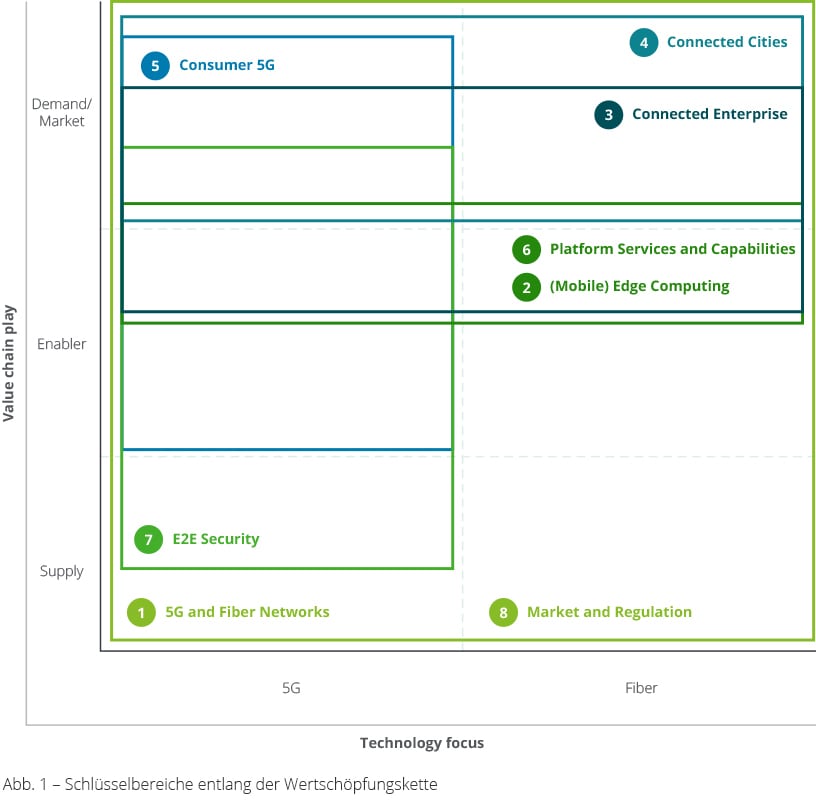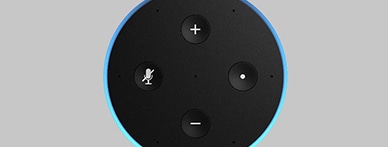Article
5G & Fiber: Next Generation Networks
Shaping the Interconnected Life and Business
5G and fiber next generation networks are currently key topics within the TMT industry, with significant investments and a great range of potential use-cases. One thing is certain: 5G and fiber will become an integral part and pivotal point for the future of both private and industrial applications. While applications for both technologies might not necessarily be the same, together they definitely have the potential to transform many areas of work and life: Smart homes, smart cities, augmented reality and the transformation of industrial processes are just a few of the things that are in store for us.
The future of 5G and fiber networks will be decided in eight playing fields that cover different parts of the value chain:

5G/ Fiber-Networks
Combining the high speed, low latency, and massive IoT support of 5G with fiber technology creates unprecedented opportunities. Especially for TMT companies as traditional operators and providers of network and connectivity solutions, business cases, operating models and B2B strategies are set to change dramatically in this new technological environment.
(Mobile) Edge-Computing
Increased automation in combination with ever-more integrated business processes require the constant, uninterrupted exchange and analysis of vast amounts of data and analysis, preferably in real time. The low-latency characteristics of 5G technologies are predestined to become the backbone of advanced connected IT and cloud systems with integrated data analytics capabilities. For example, the coordination and pathfinding of automated guided vehicles in fully autonomous manufacturing environments requires complex optimization decisions based on real-time data, a feat that quickly overwhelms current network capabilities.
5G & Connected Enterprise
5G technologies are one of the core enablers of Industry 4.0, particularly in terms of advanced automation. As such, they present a huge opportunity for companies to defend and further increase their competitive edge, paving the way to success also for future generations. Use-cases are not limited to manufacturing, but include in-plant logistics, network operations, and many more. With a number of pilot projects already on the way, this area appears to showcase the most promising applications of 5G technology.
Connected Cities
There is no doubt that societal and environmental changes require us to rethink and redesign our cities. 5G technologies are an integral aspect in solving this challenge, providing the necessary power to manage the volume of data generated by tens of thousands of sensors in a truly smart city. Whether it is traffic management, waste management, security or disaster prevention, 5G holds vast potential for better and more efficient solutions for the connected and sustainable city of the future.
Consumer 5G
Contrary to intuition formed by ubiquitous marketing for 5G-ready smartphones and data tariffs, promising 5G use-cases for consumers are yet to be defined. Current bandwidths already sufficiently cover most consumer needs, resulting in a monetization challenge for 5G. As a consequence, 5G applications in this area will need to think two steps ahead and focus on future usage scenarios that can leverage the full capabilities of 5G for consumers, such as VR/AR, e.g. in a gaming context, or the (inter-)connected car.
Platform Services & Capabilities
Due to the large number of possible use cases and solutions, the need for platforms that enable a structured and bundled exchange between supply and demand - similar to the APP stores familiar from smartphone use - will also quickly arise in the 5G/ fiber era. This can ease the transition to the new technology and will strengthen the importance and proliferation of 5G. And it will help providers to operate profitably earlier and thus gain a competitive advantage.
E2E Security
With 5G and its applications, the amount of sensitive data will increase dramatically. In this context, cybersecurity will become even more relevant than it is today. After all, in sensitive and time-critical applications that rely on the timely provision of information and instructions, any interruption in connectivity can lead to a wide range of issues. But there are also innovative solutions here: For example, 5G network slicing enables an additional layer of security, allowing users to set up their own private virtual network within the larger 5G network.
Market & Regulation
The frequent discussions on national security concerns in connection with 5G rollouts highlight the political dimension of 5G technology. Here, the regulatory balancing act must be to take into account both public security needs and to allow for harvesting the huge potential of 5G. Dealing with complexity, costs, antitrust aspects, and data security concerns is a major challenge for all stakeholders. That is why efficient regulation and wise handling of the aforementioned aspects must be ensured at an early stage. In particular, the creation of opportunities for closer cooperation between network operators will also be crucial for the actual speed of expansion of 5G and optical fiber.
Success factors to win the game
The race for 5G and fiber is already in full swing. Traditionally, established network operators would take the lead here. But for 5G and fiber, the competitive landscape has become a crowded battleground of telcos, hardware suppliers, and new infrastructure providers. It will be crucial to quickly occupy strategic control points. However, in such a complex environment and given the existing time pressure, no player will be able to build up all the necessary competencies alone. This is why cooperation models will play an essential role. Hence, widely accepted, standardized interfaces will be key to reduce complexity, uncertainty and costs.
Partner Telco Strategy & Transformation, Deloitte Germany











